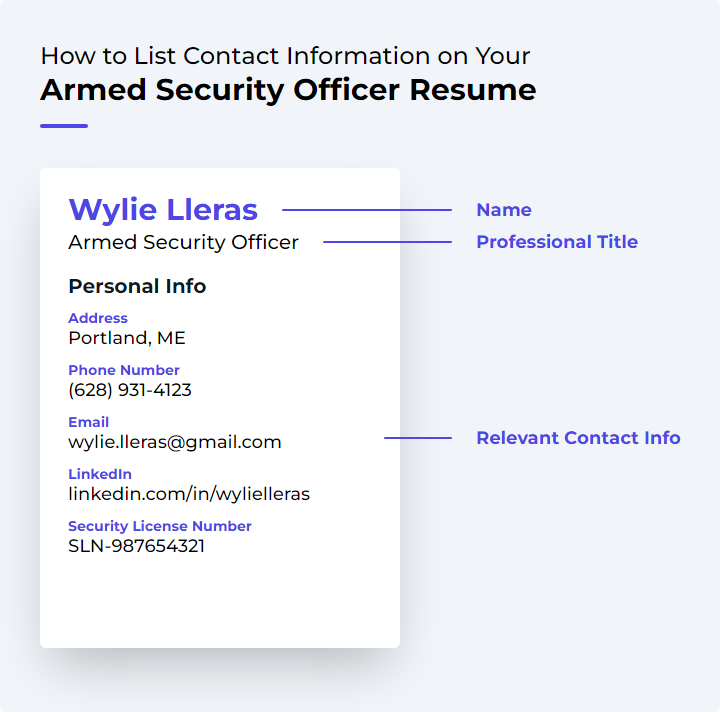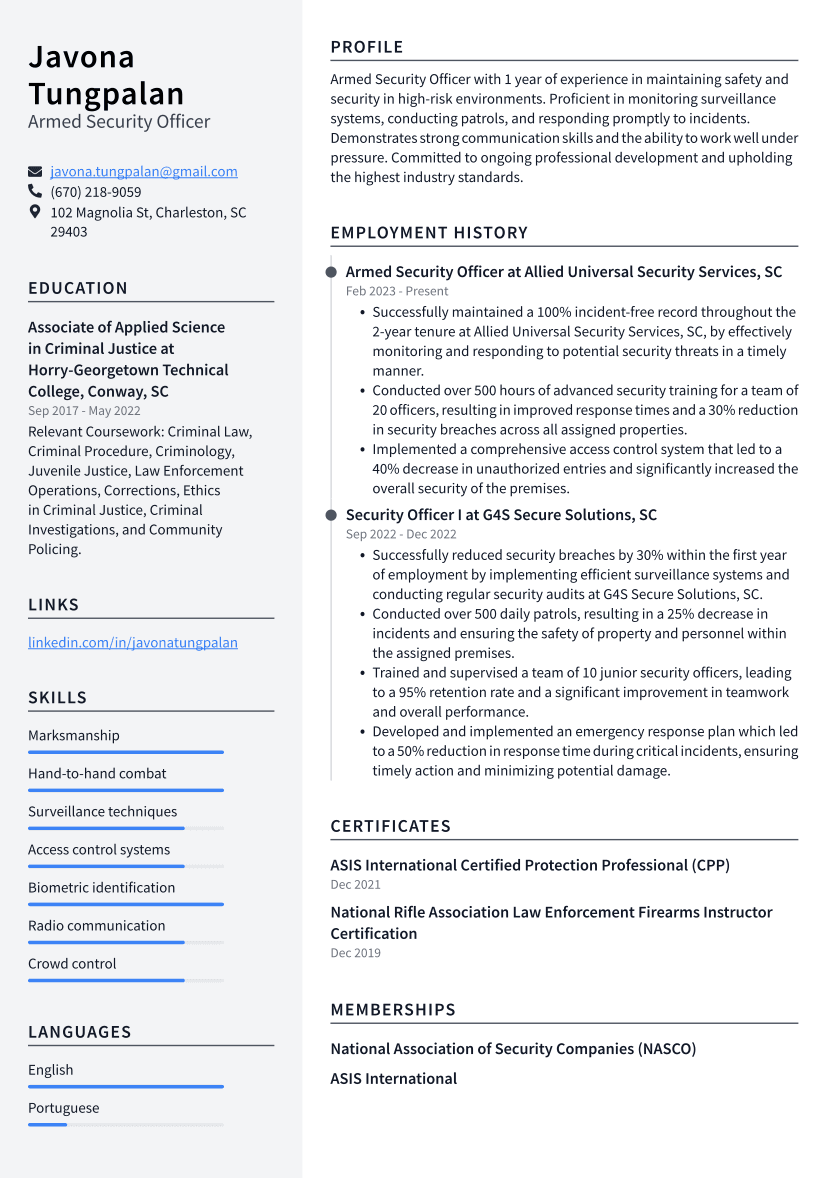Armed Security Officer Resume Examples
Writing a great armed security officer resume is important because it is one of the first things a potential employer will see when they are considering you for a position. It is your opportunity to make a good first impression and sell yourself as the best candidate for the job.
Create your resume
Select from 7 professional resume templates
If you're looking for inspiration when it comes to drafting your own armed security officer resume, look no further than the samples below. These resumes will help you highlight your experience and qualifications in the most effective way possible, giving you the best chance of landing the armed security officer job you're after.
Essential Components of an Armed Security Officer Resume
An Armed Security Officer's resume is a critical document that outlines their expertise, capabilities, and professional history. It serves as the initial point of contact with potential employers, highlighting the candidate's proficiency in handling high-risk scenarios, firearm safety, and adherence to legal protocols. A well-structured resume should effectively convey the officer's adeptness in risk assessment, emergency response, surveillance operations, and physical security maintenance. Below, we delve into the integral elements of a resume for an Armed Security Officer, offering insights on their significance and tips for optimizing each section.
1. Contact Information
The Contact Information section is fundamental for an Armed Security Officer, facilitating employer communication regarding job opportunities.

At the top of your resume, include your full name, address, phone number(s), and a professional email address. A LinkedIn profile can also be added if it's relevant and well-curated.
Ensure your email address reflects professionalism, ideally incorporating your first and last name. A phone number with a voicemail service is recommended, ensuring a professional greeting is in place. While including a home address is optional, it can be beneficial if employers have a preference for local candidates.
The Contact Information section is not only a means for employers to reach you but also an opportunity to make a positive impression through attention to detail and professionalism.
- Name: Clearly state your full name at the resume's outset.
- Email: Opt for a professional email address.
- Phone Number: Ensure it's linked to a professional voicemail service.
- Home Address: Include if comfortable and relevant to the job location.
- LinkedIn Profile: Add if it's pertinent and well-maintained.
2. Objective Statement
The Objective Statement is a concise and targeted introduction to your resume, providing employers with a glimpse of your career goals and aspirations. For an Armed Security Officer, it should highlight your commitment to safety and security, emphasizing your readiness to enforce protocols and protect property and lives.
An example statement might read: "A seasoned professional with extensive experience in law enforcement, seeking a challenging Armed Security Officer position to leverage conflict resolution, surveillance, emergency response, and firearms expertise."
Align your objective with the employer's needs, and mention any pertinent certifications or specialized training, such as firearm permits or first aid certifications, to reinforce your qualifications.
Related: Top Armed Security Officer Resume Objective Examples
3. Work Experience
The "Work Experience" section chronicles your professional journey, detailing previous roles and accomplishments within the security field. It's essential to provide a clear picture of your capabilities and experience level to potential employers.
- Job Title: List your job title, employer's name, location, and employment dates.
- Responsibilities: Describe your duties with specific bullet points under each job title.
- Achievements: Highlight any notable accomplishments or awards received.
- Relevant Skills: Mention skills gained from these experiences that are pertinent to the job.
- Tailored Experience: Customize your resume to reflect the requirements of the job description.
Accuracy and honesty in detailing your work experience are paramount.
4. Skills and Certifications
The "Skills and Certifications" section is crucial, showcasing the specific abilities and formal recognitions that qualify you for the Armed Security Guard role.
Skills: Include a range of competencies from observation and stress management to communication, physical stamina, and legal knowledge. Certifications: Highlight essential accreditations such as state security guard licenses and firearms training, which validate your expertise in the field.Customize this section to align with the job's specific demands, ensuring that your resume resonates with the employer's requirements.
Related: Armed Security Officer Skills: Definition and Examples
Related: Armed Security Officer Certifications
5. Education and Training
The "Education and Training" section validates your foundational knowledge and specialized training, which are essential for the Armed Security Officer role. Highlight your educational background, specialized courses, and any advanced training that equips you for high-risk situations.
Include state-specific licenses or permits, especially those related to firearms, to demonstrate your eligibility for the position.
Detail your educational and training achievements in chronological order, and mention any accolades that enhance your professional standing.
6. Licenses and Permits (Firearms Specific)
Firearm-related licenses and permits are critical inclusions on your resume, confirming your legal authorization to carry and use firearms. Detail any relevant permits, such as Concealed Carry Permits or Gun Licenses, and include issuance and expiration dates, endorsements, and related training.
This section assures employers of your compliance with legal standards and your commitment to professional development in firearm safety.
7. References
References provide potential employers with insights into your work ethic and professional demeanor. Choose individuals who can attest to your reliability and expertise in security roles, such as former supervisors or colleagues from security, military, or law enforcement backgrounds.
Include complete contact information for each reference and a brief description of your professional relationship. Always obtain permission before listing someone as a reference.
While references are a crucial aspect of your resume, they can be provided upon request to conserve space for other essential details.
By meticulously crafting each section of your resume, you can present a compelling narrative of your qualifications, making a strong case for your candidacy as an Armed Security Officer.
